Well, here we are again in our burrow with time to follow up on some COVID-19 rapid testing machine technology and comment on the APS April 2020 meeting that is being conducted as a virtual meeting online.
In a previous post of March 28, 2020, we commented about how PCR technology can amplify the amount of RNA/DNA in a sample to millions or billions of times originally present and thereby provide a way of identify if the searched for virus is present. But the PCR technique is a thermal cycling technique that can take an hour or more to complete a test and yet we now see in TV news broadcasts of a new test that is coming online that can make the same test in just 5 minutes or so. How does this new test do this? Well, as an old, former Big Oil instrument engineer, I said let's just go find the operator manual for this new test machine and we can see what they are doing now. So, in this screenshot from Abbott we can see the ID NOW tester, which is very portable and can complete the test anywhere, particularly important now, right at the patient's bedside or automobile window. This tester can handle about a hundred tests per day and other larger, more fully automated testers, weighing a thousand lbs. or more, in hospital settings, can test thousands of samples per day.
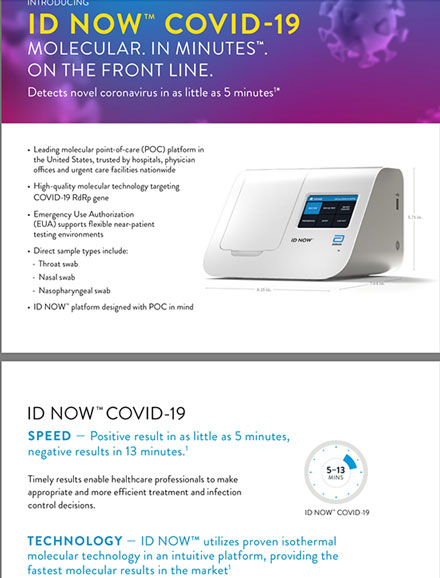 | |
|
The ID NOW test technique relies on isolthermal testing of the sample, not the slower thermal cycling required of the PCR test. The ID NOW test kit comes with the required reagents and RNA primers and transcriptases to conduct the test directly and quickly on samples taken from the patient. Because of the pandemic situaltion both the tester and test kits have not gone though rigorous FDA testing, but have been granted an Emergency Use Authorization. The sample is transferred from the swab to little vials and then inserted into the tester at the same time. The video screen on the tester collects patient data and tells the operator the step by step process and final results.
 |
| Real Time SARS-CoV-2 Assay Kit (Source: www.abbott.com) |
So, how does this portable tester amplify the RNA/DNA in the sample by millions or billions of time in less than five minutes. The manual says it does it isothermally rather than doing thermal cycling like for the PCR technology. Remember the PCR cycles between several temperatures many times in order to first separate the DNA strands, and then cool them down so that the replication can take place, and then repeat the whole cycle again and again.
One possible technology is called Loop-mediated Isothermal Amplification (LAMP). The LAMP technology achieves almost the same performance as thermal cycling PCR, but does it much faster and simpler. LAMP development is described in a 2000 paper by T. Notomi, et al, who were at Eiken Chemical Co. in Japan, That paper is very technical and the technique is explained in simpler terms this Wikipedia article. Even still this description is quite technical. One thing that stood out for me is that this technique attaches a fluorescent protein to the sample so that to check for the presence of the virus you just have to look if it emits light at the end of the amplification process. Pretty neat!
 |
| LAMP Technology delivers isothermal RNA/DNA amplification faster than thermo-cycling PCR (Source: Wikipedia) |
Ok, after that followup on one version of COVID-19 testing, let's get right back into the APS April 2020 meeting. This blog post covers just one of the exciting areas of research in astronomy where Gaia satellite measurements are used to gain a better understanding of the history of the Milky Way galaxy.
But first, let's just remember that this APS April meeting is being conducted online. All of the presenters and all of the attendees were off at their own bunkers. So, it was kind of interesting to see one of the plenary session speakers deliver his keynote presentation, "Exoplanets: 25 years of Exploration," make the presentation from his living room because of the pandemic lockdown. I will maybe comment about that presentation later, but for now just wanted to set the stage for what it was like as we sat down for the meeting while we attendees were in our PJ's or whatever.
 |
| Michel Mayor delivers plenary session presentation on exoplanets from the living room (Source: APS April 2020) |
The session on Gaia and LIGO was chaired by Deidre Shoemaker, who also had a visitor, who just wanted to play, show up during the session. Here you can see the disappointed Great Dane stroll off as Deidre begins the Multi Messenger Astronomy session.
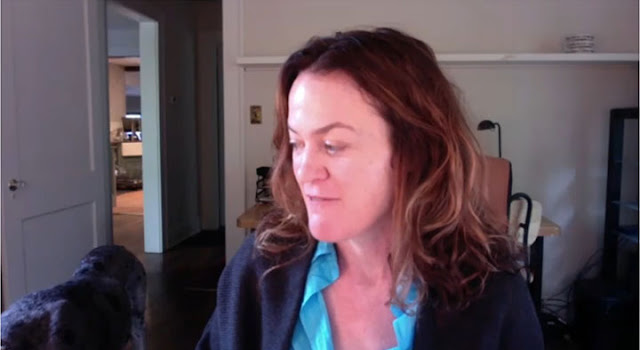 |
| Great Dane interrupts APS Plenary MMA Session Chair Deirdre (Source: D. Shoemaker, APS April 2020) |
The main paper that I was especially interested in was "New Views on the Galaxy from the Gaia Space Mission" by Amina Helmi. We are stuck inside the Milky Way galaxy and can't look at it from the outside so getting a good understanding of it has taken a long time. Now, data from the Gaia spacecraft, which provides very accurate position and velocities of millions of stars in the Milky Way is changing all of that.
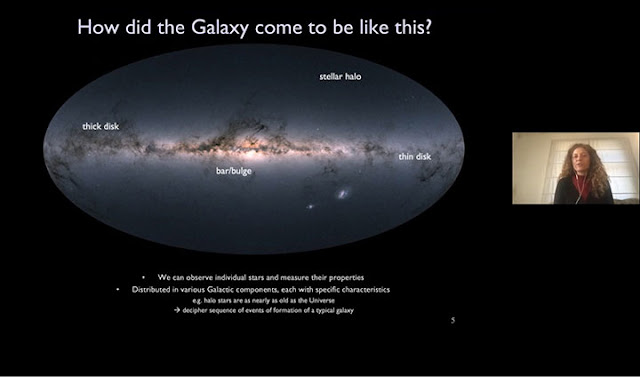 |
| How did the Milky Way come about? (Source: Amina Helmi, APS April 2020) |
It used to be that the Milky Way was considered just an island universe. Is this picture still correct? As Amina goes on to say that now using Gaia data we can look back in time and understand how the galaxy came to be the way it is.
 |
| Is the Milky an island universe? (Source: Amina Helmi, APS April 2020) |
Simulations of galaxy mergers shows that larger galaxies can shred its smaller satellite galaxies. Check out this one simulation where a satellite galaxy is drawn closer together by gravity until the gravitational forces are so strong that the satellite galaxy is shredded. The following screenshots capture the simulation at various time points in the simulation. The white stars are from the original galaxy and the red stars are from the satellite galaxy.
 | |
|
Later in the simulation, we see how the original satellite galaxy can become sort of a halo of the original galaxy. Can some earlier event like this be observed in the Gaia data for the Milky Way?
 | |
|
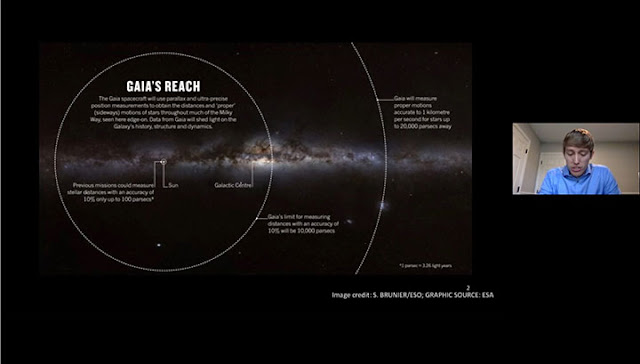 |
| How far away from the Sun can Gaia make measurements? (Source: A. Drlica-Wagner, APS April 2020) |
By looking at various combinations of position and velocity and also comparing types of stars you can isolate groups of stars that have different velocities compared to other stars in the Milky Way disk and bulge. Some of these large clumps of stars even have retrograde velocities from the normal rotational velocity of much of the Milky Way. So even though the Earth rotates around the galactic center at about 220 km/sec, these other groups move in some different direction. Many of the stars that make up the halo have this different velocity and these stars are as old or older than the stars in the disk of the galaxy.
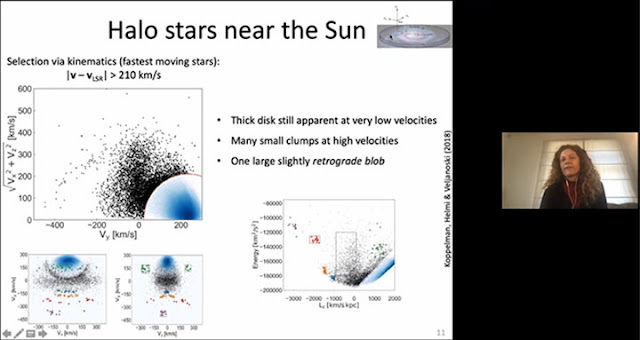 | |
|
There are also many blobs of stars that seem to have been originally part of another galaxy. These blobs can be used to help trace the history of the Milky Way.
 | ||
|
So, by examining many stars and seeing how they can be grouped by velocity, it is possible to search for and find merger debris. These stars do not have anything like the orbital velocity and angular momentum that they would have if they had been part of the original cloud of gas and dust that collapsed to form the Milky Way.
 |
| Examining the orbital dynamics and momentum of blobs as merger debris (Source: Amina Helmi, APS April 2020) |
So, Gaia is helping trace out the history and formation of the Milky Way. We do not find ourselves in an island universe, but instead in a galaxy with a rich history of collisions and cannibalism, if you will.
 | |
|
Finally, I was not sure what the Gaia-Enceladus or Gaia Sausage was, but a quick google search found the answer. The Gaia Sausage is the remains of a satellite galaxy that merged and was shredded by the Milky Way some 8-11 billion years ago. You can check out some of the details in the Wikipedia article, some of which is repeated below. Now, the simulations that Amina showed at the beginning of her presentation make a lot more sense. Thanks for all of that, Amina!
 |
| What is the Sausage or Gaia-Enceladus-Sausage?; Wikipedia describes it like this (Source: Wikipedia) |
It turns out that the remnants of the Sausage are already quite familiar to us in that they have common names from the Messier catalog and can easily be seen in the night sky.
 |
| The Gaia Sausage is made up of common globular clusters (Source: Wikipedia) |
So, that is a short summary of one of the APS April 2020 meeting sessions. I'll try to work in a few more reviews and comments later. In the meantime, you might try to go outside tonight and tomorrow and see if you can spot any of the Lyrid meteor showers.
Until next time, here from our burrow, stay sane, stay safe,
Resident Astronomer George
Be sure to check out over 400 other blog posts on similar topics
If you are interested in things astronomical or in astrophysics and cosmology
Check out this blog at www.palmiaobservatory.com

No comments:
Post a Comment